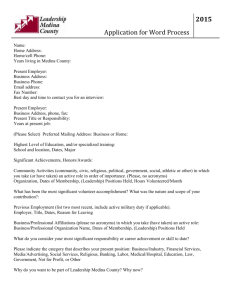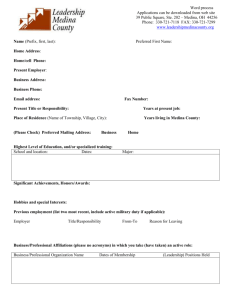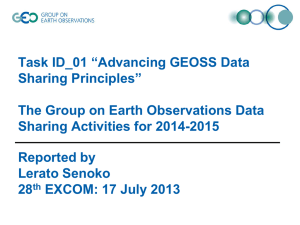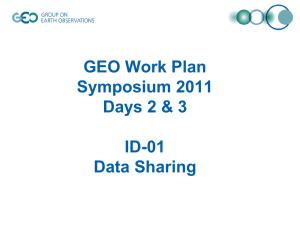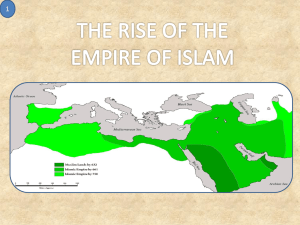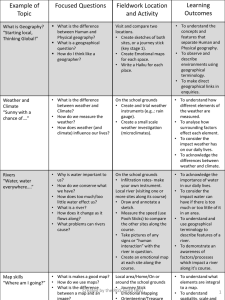ppt - GEO Tasks.org
advertisement
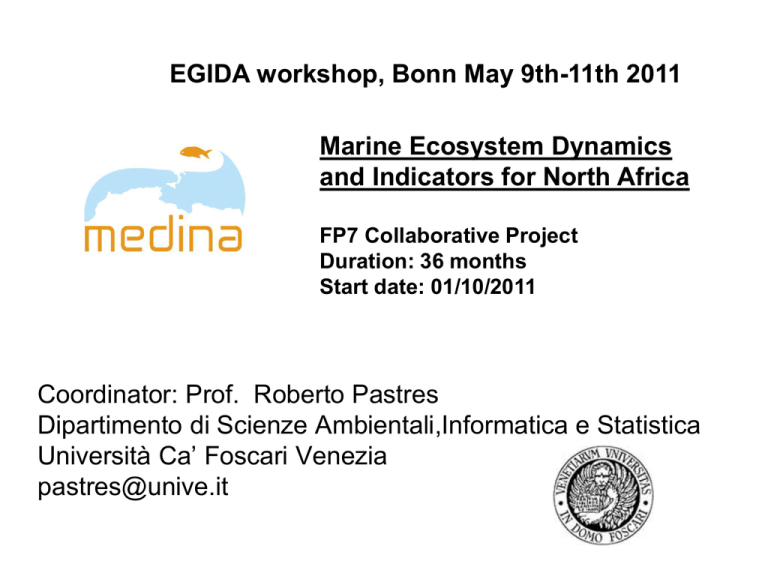
EGIDA workshop, Bonn May 9th-11th 2011 Marine Ecosystem Dynamics and Indicators for North Africa FP7 Collaborative Project Duration: 36 months Start date: 01/10/2011 Coordinator: Prof. Roberto Pastres Dipartimento di Scienze Ambientali,Informatica e Statistica Università Ca’ Foscari Venezia pastres@unive.it Participant no. Participant organisation name Country 1 Università “Ca’ Foscari” Venezia IT 2 Universitat Autònoma de Barcelona ES 3 Universidade Pablo de Olavide ES 4 Université Abdelmalek ESSAADI 5 UNEP-MAP Centre Regional Activity for Specially Protected Areas 6 Joint Research Centre - EC 7 National Inst. for Oceanography and Fisheries 8 Union International pour la Conservation de la Nature et de ses ressources 9 Commissariat National du Littoral 10 Plymouth Marine Laboratory 11 ACRI Etudes et Conseil Morocco 12 European Space Agency FR 13 Consiglio Nazionale delle Ricerche - Istituto di metodologie per l'analisi ambientale IT Morocco Tunisia EU Egypt CH Algeria GB Overall objectives: -To contribute to the assessment of coastal ecosystem status in North African countries; -To enhance the monitoring capacity for those regions. -To identify major risks due to climate change, thus aiding the development of adaptation strategies. -To feedback MEDINA’s scientific contribution within the EU regulatory framework, as part of the mutual exchange between North Africa and European Countries. -To ensure the optimal exploitation of the GEOSS Common Interface capabilities in providing the appropriate infrastructure for fusion of satellite Earth Observation and conventional monitoring data. -To promote international cooperation for sharing data and services with on-going EU efforts, with the relevant GEO Community of Practices and with GOOS-Africa MEDINA’s key features -1: S&T component - Adoption of the Driver-Pressure-State-Impact-Response conceptual framework for on-going monitoring and assessment of coastal marine ecosystems. - Selection of Pressure and State/Impact indicators - Use of Land Ecosystem Account methodology for estimating pressures in data poor areas - Use of biogeochemical, Habitat Suitability and food web models for establishing causal links between Drivers/Pressures and State/Impact, for scenario analysis and for assessing societal Responses. - Fusion of remotely-sensed and in-situ observation, through modelling, for monitoring optimizations - Integrated approach to ecosystem assessment, with active involvement of local monitoring agencies and stakeholders. MEDINA key features – 2: Information Technology component Set up of an e-infrastructure fully compatible with GEOSS GCI and available from that. MEDINA’s key features – 3 Capacity Building component - Active involvement of NA participants in the inventory of monitoring activities, selection and investigation of five Pilot Cases (use scenarios) - Training courses for environmental protection agency personnel, to be held in the EU (Italy, Spain, Great Britain); - Set-up of an end-user committee, for assissting in the overall ecosystem assessment; - Kick-off, annual and project closure meetings organized by NA participants, in Egypt, Tunisia, Algeria, Morocco; - Additional National Workshops (M25-M30) to present MEDINA results to stakeholders and local authorities. MEDINA’s key features – 4 Integrating the Components Key to the integration of the S&T, IT and CB components is the application of MEDINA’s approach to five pilot, cases, to be selected during the first year on the basis of the priority issues of each country (EEA, 2006). Priority issues Morocco Algeria Tunisia Libya Extended capture fisheries Eutrophication HABs Invasive species in ballast water Changes/loss in seagrass meadows Coastal wetland changes Chemical pollution from industries Chemical pollution from cities Organic pollution from city (missing WWTP) Chemical pollution from maritime trafic Chemical pollution from agricolture (N,P, pesticides) Chemical pollution from oil industry Macro-waste dumping Littoral Erosion Pressures from unregulated tourism development Pressures from coastal urbanization Egypt WP3 – Deliverables D3.1 MEDINA reference catalogue D3.2 MEDINA e-infrastructure services Components include a data/models viewer, catalogue access services, suite of OGC-compliant services for downloading, overlaying, and manipulating spatial data D3.3 MEDINA and GEOSS/GCI: report on system interactions. Description of problems/issues in ensuring the interoperability and interactions between the MEDINA e-infrastructure and the GEOSS. (and how they were dealt with) D3.4 Assessment of GEOSS infrastructure exploitation in the context of coastal ecosystem monitoring Based on gaps evaluation, it will contain recommendations on how to best exploit GEOSS in this particular topic. MEDINA’s management structure PMB: responsible for day to day management; PTB: ultimate decision body: supports the PMB in major administrative and technical decisions PAB: experts and stakeholder from a range of private and public bodies will provide PMB and PTB with input and advice. MEDINA Expected impacts – 1: GEOSS - MEDINA will deliver inventories on the availability and usability of data sources, data processing and chaining services, data storage and access means, data preservation and metadata standards used for describing data - Results, based on the exploitation of the GCI, will highly impact on the recent AIP-3 effort: via the implementation of selected pilot case studies, the project will demonstrate a real use case exploitation of the GCI in the Water thematic area, never addressed before within AIP-x efforts. - MEDINA will enrich the GCI with ad-hoc components and datasets aimed at enabling coastal ecosystem monitoring and will focus on a particular geographic area for which the GEO entry level barrier is still high - MEDINA will also provide valuable input as GEOSS Best Practice on the (sub-)topics: fishery/census of marine life; marine coastal areas; North African countries. MEDINA expected impact – 2: S&T and Capacity Building - The advanced technological means put at disposal by the MEDINA einfrastructure will enhance NAs current experience for integrated data access, to visualise near real time information as well as to compute future trend evolutions of key climate variables. -MEDINA will address research issues on modelling water bodies, food web and ecosystems’ productivity, services and health. - It will as well look deeper on NA city “metabolism” and its relevance to coastal ecosystems. - Via selected scenarios, the project will be able to propose cost-effective monitoring and adaptation strategies. MEDINA expected impact – 3: implementation of International Protocols and feedback on EU WFD and MSFD MEDINA will contribute to the harmonisation of national monitoring programs, through the: -standardisation of sampling and analytical procedures; -the set up of quality control systems; -the establishment of a common methodological framework for the assessment of ecosystem status;

